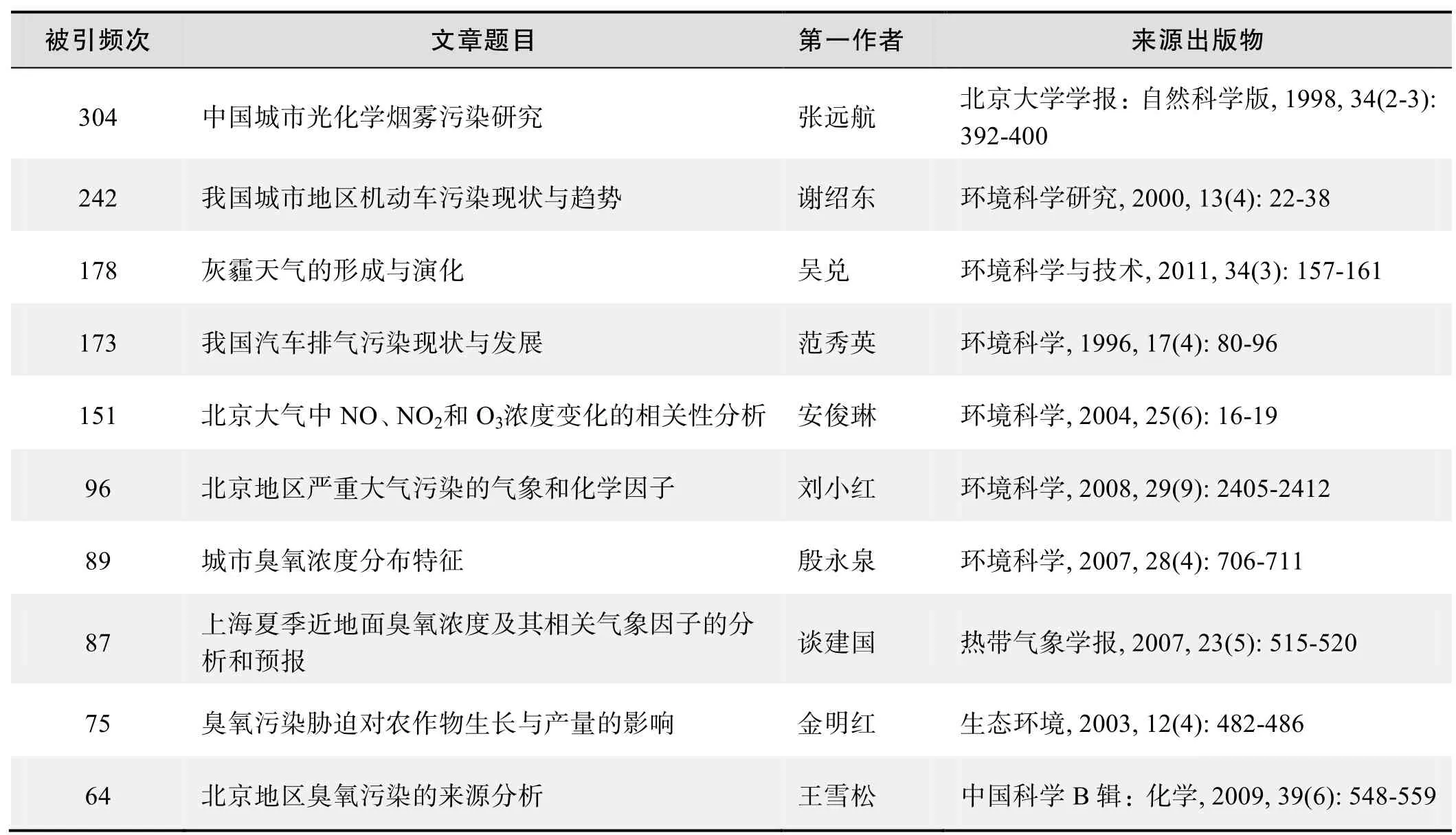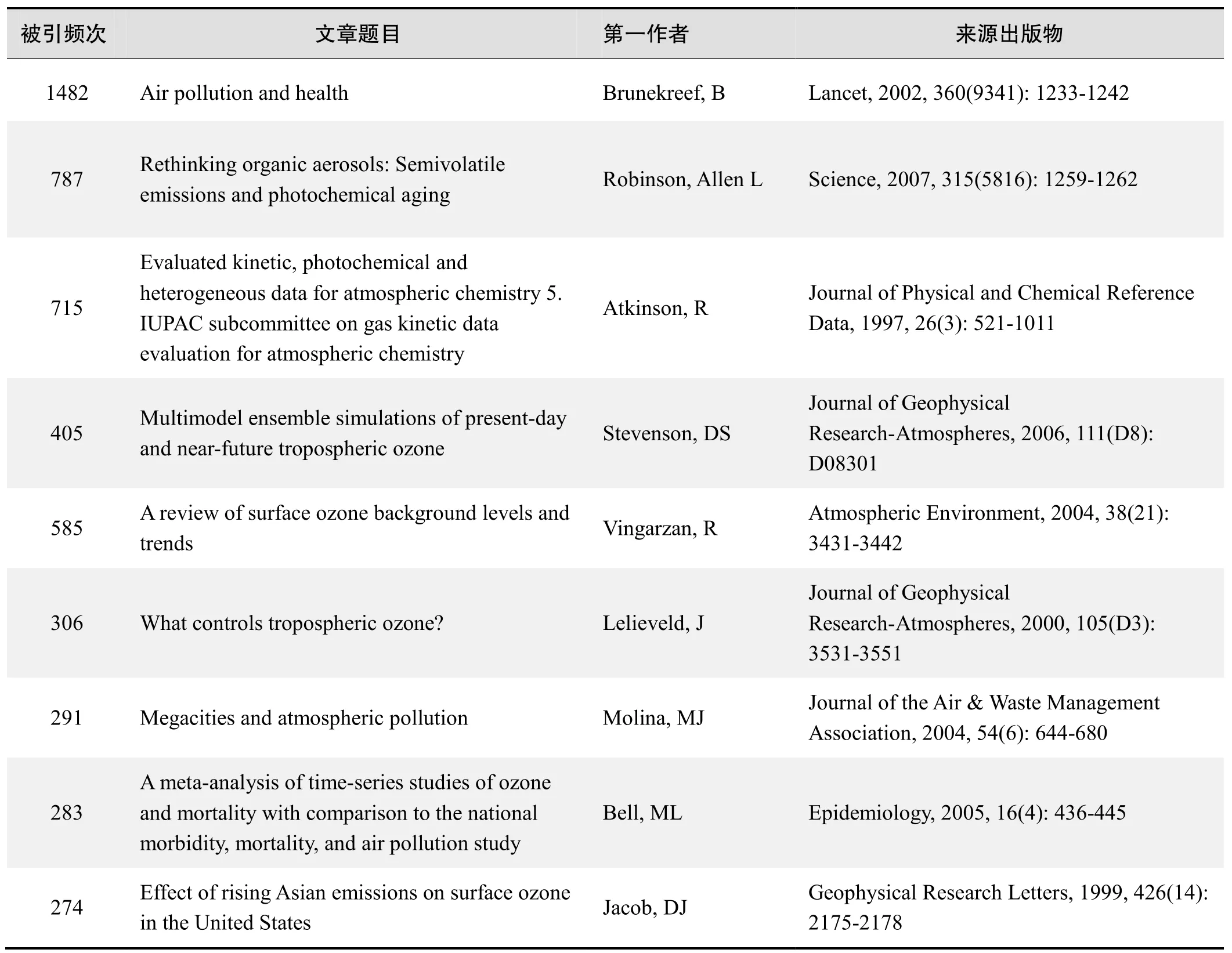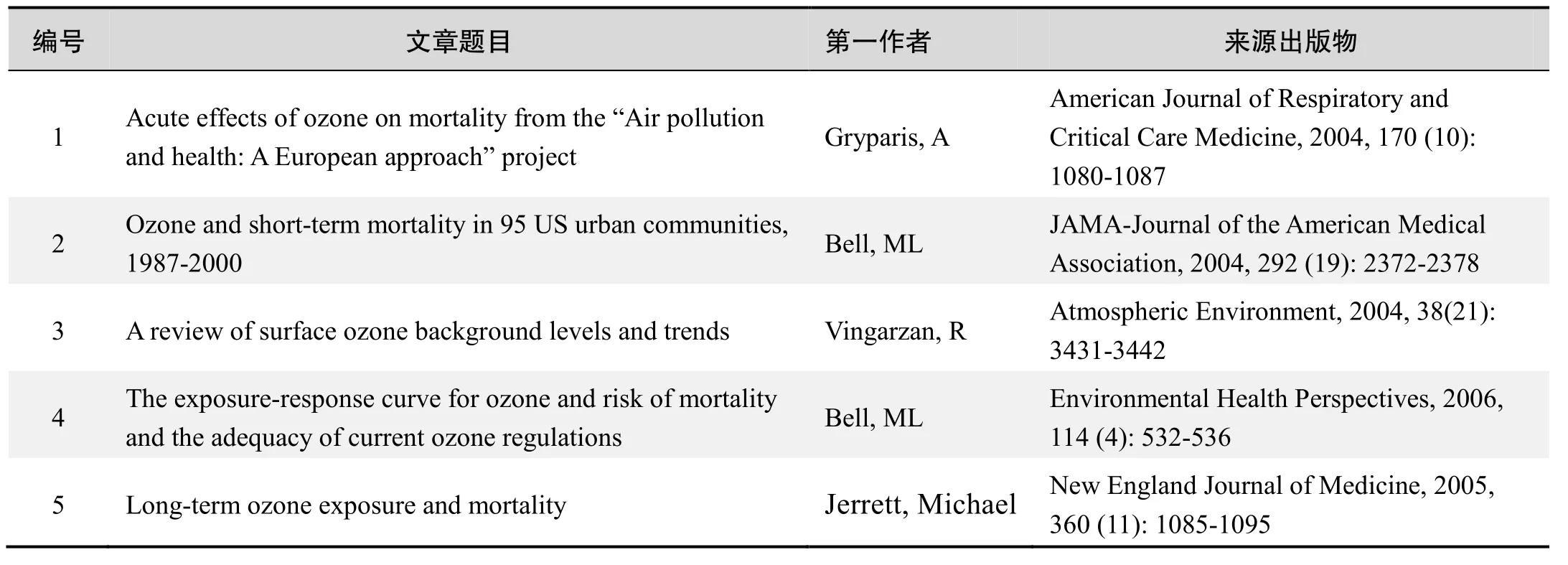臭氧污染
2017-06-29
臭氧污染
·编者按·
中国环境监测总站预报,2017年5月份立夏以来,全国空气质量总体一般,大部地区以良至轻度污染为主,部分地区受沙尘和臭氧污染影响可能出现中度或以上污染。近期持续的高温天气,加剧了京津冀及周边地区的大气污染,臭氧成为首要污染物。
臭氧原本应该集中在高层大气帮助人类抵御紫外线侵害,与高空中的臭氧层不同,由于臭氧具有的强氧化性,近地面的臭氧则是一种有害气体。如果空气中的臭氧浓度过高,很容易引起上呼吸道的炎症病变,出现咳嗽、头疼等症状,还会对皮肤、眼睛、鼻黏膜产生刺激。
中国臭氧研究工作在近 30年期间内取得了一些成绩,针对中国大气臭氧光化学特征先后开展了烟雾箱实验、地面观测、卫星遥感和模式模拟等相关研究工作,大气化学观测技术和研究方法也渐趋成熟,但仍有许多工作需要进一步开展和研究。
本专题得到专家范绍佳教授(中山大学大气科学学院)、谢旻教授(南京大学大气环境研究中心)的大力支持。
·热点数据排行·
截至2017年6月1日,中国知网(CNKI)和Web of Science(WoS)的数据报告显示,以“臭氧污染(ozone pollution)”“光化学烟雾(photochemical smog)”为词条可以检索到的期刊文献分别为3460条与10554条,本专题将相关数据按照:研究机构发文数、作者发文数、期刊发文数、被引用频次进行排行,结果如下。

研究机构发文数量排名(CNKI) 研究机构发文数量排名(WoS)

作者发文数量排名(CNKI) 作者发文数量排名(WoS)

期刊发文数量排名(CNKI) 期刊发文数量排名(WoS )
根据中国知网(CNKI)数据报告,以“臭氧污染(ozone pollution)”“光化学烟雾(photochemical smog)”为词条可以检索到的高被引论文排行结果如下。

国内数据库高被引论文排行
根据Web of Science数据统计,以“臭氧污染(ozone pollution)”“光化学烟雾(photochemical smog)”为词条可以检索到的高被引论文排行结果如下。

国外数据库高被引论文排行
·经典文献推荐·
基于 Web of Science检索结果,利用Histcite软件选取 LCS(Local Citation Score,本地引用次数)TOP50文献作为节点进行分析,得到本领域推荐的经典文献如下。

本领域经典文献
Acute effects of ozone on mortality from the “Air pollution and health: A European approach” project
cardiovascular mortality; respiratory mortality; time series
来源出版物:American Journal of Respiratory and Critical Care Medicine, 2004, 170 (10): 1080-1087
Ozone and short-term mortality in 95 US urban communities, 1987-2000
Bell, ML; McDermott, A; Zeger, SL; et al.
Abstract:Context: Ozone has been associated with various adverse health effects, including increased rates of hospital admissions and exacerbation of respiratory illnesses. Although numerous time-series studies have estimated associations between day-today variation in ozone levels and mortality counts, results have been inconclusive. Objective: To investigate whether short-term (daily and weekly) exposure to ambient ozone is associated with mortality in the United States. Design and Setting: Using analytical methods and databases developed for the National Morbidity, Mortality, and Air Pollution Study, we estimated a national average relative rate of mortality associated with short-term exposure to ambient ozone for 95 large US urban communities from 1987-2000. We used distributed-lag models for estimating community-specific relative rates of mortality adjusted for time-varyingconfounders (particulate matter, weather, seasonality, and long-term trends) and hierarchical models for combining relative rates across communities to estimate a national average relative rate, taking into account spatial heterogeneity. Main Outcome Measure Daily counts of total non-injury-related mortality and cardiovascular and respiratory mortality in 95 large US communities during a 14-year period. Results: A 10-ppb increase in the previous week's ozone was associated with a 0.52% increase in daily mortality (95% posterior interval [PI], 0.27%-0.77%) and a 0.64% increase in cardiovascular and respiratory mortality (95% PI, 0.31%-0.98%). Effect estimates for aggregate ozone during the previous week were larger than for models considering only a single day’s exposure. Results were robust to adjustment for particulate matter, weather, seasonality, and long-term trends. Conclusions: These results indicate a statistically significant association between short-term changes in ozone and mortality on average for 95 large US urban communities, which include about 40% of the total US population. The findings indicate that this widespread pollutant adversely affects public health.
来源出版物:JAMA-Journal of the American Medical Association, 2004, 292 (19): 2372-2378
A review of surface ozone background levels and trends
Vingarzan, R
Abstract:A survey of the literature was conducted to review historical and current surface ozone data from background stations in Canada, United States and around the world for the purpose of characterizing background levels and trends, present plausible explanations for observed trends and explore projections of future ozone levels. The annual ozone cycle at background sites in the Northern Hemisphere is characterized by a spring maximum, peaking during the month of May. Although presently there is no concensus as to the origin of the spring maximum, evidence supports both enhanced photochemistry in the free troposphere and stratospheric input. Modern day annual average background ozone concentrations over the midlatitudes of the Northern Hemisphere range between approximately 20-45 ppb, with variability being a function of geographic location, elevation and extent of anthropogenic influence. Annual median ozone levels at Canadian background stations fall between 23 and 34 ppb, a range similar to that reported for low-elevation background stations in the United States and around the world. Comparisons of ozone levels with those measured over a century ago indicate that current levels have increased by approximately two times. Although current trends are not uniform, there is some indication that background ozone levels over the midlatitudes of the Northern Hemisphere have continued to rise over the past three decades, and that this rise has been in the range of approximately 0.5%-2% per year. Rising trends were steeper in the 1970s and 1980s compared to the 1990s, which have seen either a leveling off or a decline in the magnitude of these trends. Model sensitivity studies indicate that the rise in NO, emissions account for the greatest increase in background ozone levels over the past three decades. A substantial component of the background ozone concentration in western North America may be due to long-range transport of Asian pollution, especially during the spring months. Model projections using IPCC emission scenarios for the 21st century indicate that background ozone may rise to levels that would exceed internationally accepted environmental criteria for human health and the environment.
关 键 词 :background ozone; ozone trends; spring maximum; tropospheric ozone; ozone projections
来源出版物:Atmospheric Environment, 2004, 38(21): 3431-3442
The exposure-response curve for ozone and risk of mortality and the adequacy of current ozone regulations
Bell, ML; Peng, RD; Dominici, F
Abstract:Time-series analyses have shown that ozone is associated with increased risk of premature mortality, but little is known about how O3affects health at low concentrations. A critical scientific and policy question is whether a threshold level exists below which O3does not adversely affect mortality. We developed and applied several statistical models to data on air pollution, weather, and mortality for 98 U.S. urban communities for the period 1987-2000 to estimate the exposure-response curve for tropospheric O3and risk of mortality and to evaluate whether a “safe” threshold level exists. Methods included a linear approach and subset, threshold, and spline models. All results indicate that any threshold would exist at very low concentrations, far below current U.S. and international regulations and nearing background levels. For example, under a scenario in which the U.S. Environmental Protection Agency’s 8-hr regulation is metevery day in each community, there was still a 0.3% increase in mortality per 10-ppb increase in the average of the same and previous days’ O3levels (95% posterior interval, 0.15%-0.45%). Our findings indicate that even low levels of tropospheric O3are associated with increased risk of premature mortality. Interventions to further reduce O3pollution would benefit public health, even in regions that meet current regulatory standards and guidelines.
关键词:mortality; ozone; regulations; threshold
来源出版物:Environmental Health Perspectives, 2006, 114 (4): 532-536
Long-term ozone exposure and mortality
Jerrett, Michael; Burnett, Richard T; C. Arden, Pope. III.; et al.
Abstract:Background: Although many studies have linked elevations in tropospheric ozone to adverse health outcomes, the effect of long-term exposure to ozone on air pollution-related mortality remains uncertain. We examined the potential contribution of exposure to ozone to the risk of death from cardiopulmonary causes and specifically to death from respiratory causes. Methods: Data from the study cohort of the American Cancer Society Cancer Prevention Study II were correlated with air-pollution data from 96 metropolitan statistical areas in the United States. Data were analyzed from 448850 subjects, with 118777 deaths in an 18-year follow-up period. Data on daily maximum ozone concentrations were obtained from April 1 to September 30 for the years 1977 through 2000. Data on concentrations of fine particulate matter (particles that are lessthan/equal 2.5 microm in aerodynamic diameter [PM2.5]) were obtained for the years 1999 and 2000. Associations between ozone concentrations and the risk of death were evaluated with the use of standard and multilevel Cox regression models. Results: In single-pollutant models, increased concentrations of either PM2.5or ozone were significantly associated with an increased risk of death from cardiopulmonary causes. In two-pollutant models, PM2.5was associated with the risk of death from cardiovascular causes, whereas ozone was associated with the risk of death from respiratory causes. The estimated relative risk of death from respiratory causes that was associated with an increment in ozone concentration of 10 ppb was 1.040 (95% confidence interval, 1.010 to 1.067). The association of ozone with the risk of death from respiratory causes was insensitive to adjustment for confounders and to the type of statistical model used. Conclusions: In this large study, we were not able to detect an effect of ozone on the risk of death from cardiovascular causes when the concentration of PM2.5was taken into account. We did, however, demonstrate a significant increase in the risk of death from respiratory causes in association with an increase in ozone concentration.
来源出版物:New England Journal of Medicine, 2005, 360 (11): 1085-1095
Gryparis, A; Forsberg, B; Katsouyanni, K; et al
In the Air Pollution and Health: A European Approach (APHEA2) project, the effects of ambient ozone concentrations on mortality were investigated. Data were collected on daily ozone concentrations, the daily number of deaths, confounders, and potential effect modifiers from 23 cities/areas for at least 3 years since 1990. Effect estimates were obtained for each city with city-specific models and were combined using second-stage regression models. No significant effects were observed during the cold half of the year. For the warm season, an increase in the 1-hour ozone concentration by 10 μg/mL was associated with a 0.33% (95% confidence interval [CI], 0.17-0.52) increase in the total daily number of deaths, 0.45% (95% CI, 0.22-0.69) in the number of cardiovascular deaths, and 1.13% (95% CI, 0.62-1.48) in the number of respiratory deaths. The corresponding figures for the 8-hour ozone were similar. The associations with total mortality were independent of SO2and particulate matter with aerodynamic diameter less than 10 mum (PM10) but were somewhat confounded by NO2and CO. Individual city estimates were heterogeneous for total (a higher standardized mortality rate was associated with larger effects) and cardiovascular mortality (larger effects were observed in southern cities). The dose-response curve of ozone effects on total mortality during the summer did not deviate significantly from linearity.
